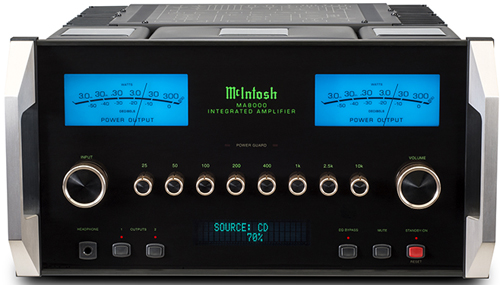McIntosh launches MA8000 300-watt integrated amplifier
The new MA8000 comes with a five-input DAC, high-quality headphone output and dedicated MM and MC phono stage

McIntosh has unveiled the MA8000 300-watt integrated amplifier, which has been designed as a modern audiophile system 'hub'.
The unit incorporates a five-input DAC with decoding up to 32-bit/192kHz for digitally connected devices, while a total of 15 inputs are on offer – including six line-level; two balanced; five digital; and a high-quality MM and MC phono input.
MORE: McIntosh introduces new compact amps, Media Bridge and headphones
The five digital inputs comprise two assignable coaxial and two assingable optical, along with a dedicated asynchronous USB 2.0; which can operate up to 32-bit.
Adjustable cartridge loading and impedance matching are features of the MM and MC phono inputs, which also can be optimised to support a variety of turntable and phono cartridge configurations.
Meanwhile, the MA8000 incorporates McIntosh's new High Drive headphone amplifier, which offers increased gain and output power. All headphone types are supported from 20 to 600 ohms.
MORE: McIntosh C2500 review
Get the What Hi-Fi? Newsletter
The latest hi-fi, home cinema and tech news, reviews, buying advice and deals, direct to your inbox.
If you want an exciting multichannel home cinema system, the MA8000 can oblige with the help of the Home Theatre Pass Through. McIntosh has also included its Power Guard technology, which monitors input and output signals, dynamically adjusting them when necessary.
The MA8000 is another product from McIntosh to feature the iconic blue power meters, glass-fronted fascia and retro controls. Like all products from the US manufacturer, it is handcrafted in Binghampton, New York.
You'll be able to find the McIntosh MA8000 on sale now for £10,000
MORE: See all our hi-fi amplifier reviews
Max is a staff writer for What Hi-Fi?'s sister site, TechRadar, in Australia. But being the wonderful English guy he is, he helps out with content across a number of Future sites, including What Hi-Fi?. It wouldn't be his first exposure to the world of all things hi-fi and home cinema, as his first role in technology journalism was with What Hi-Fi? in the UK. Clearly he pined to return after making the move to Australia and the team have welcomed him back with arms wide open.

